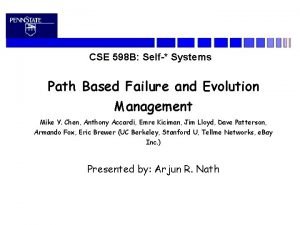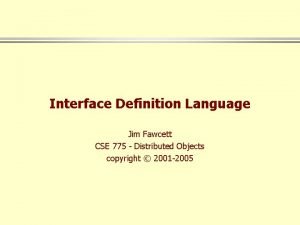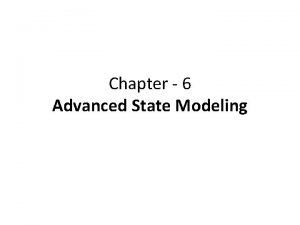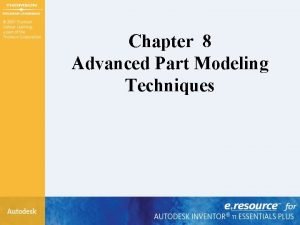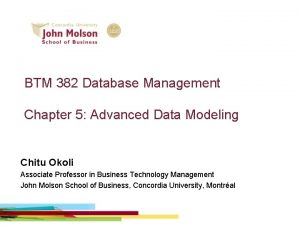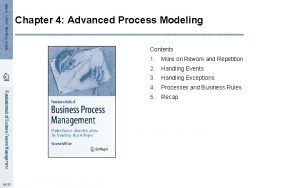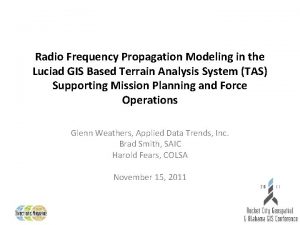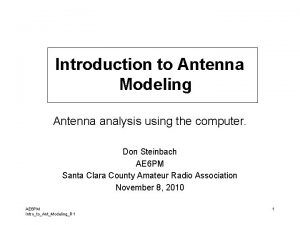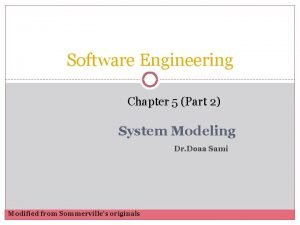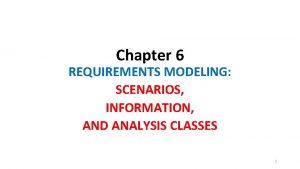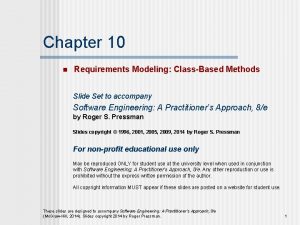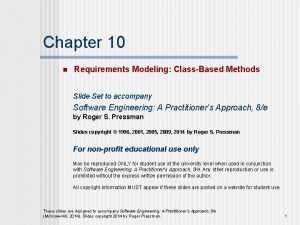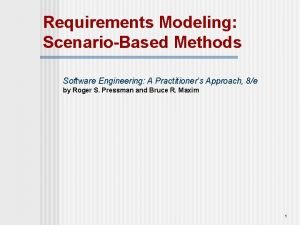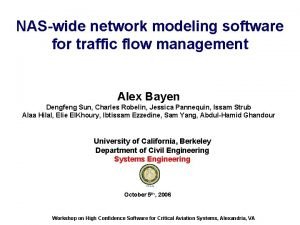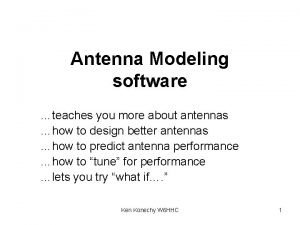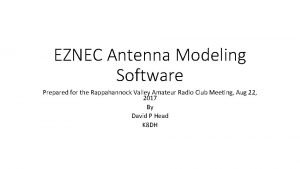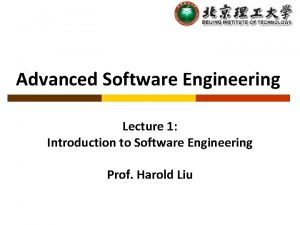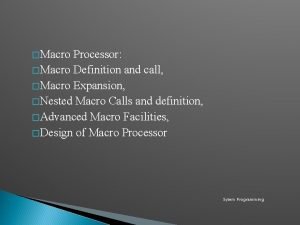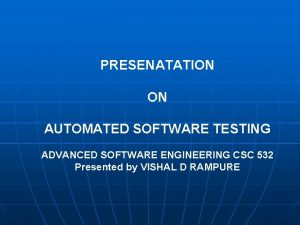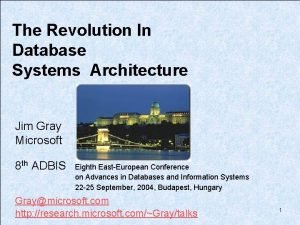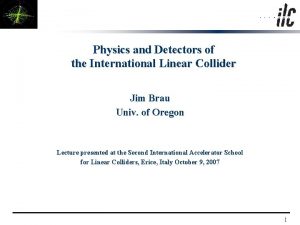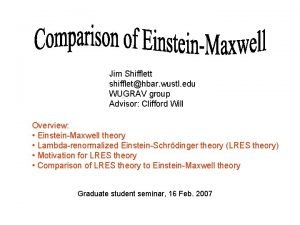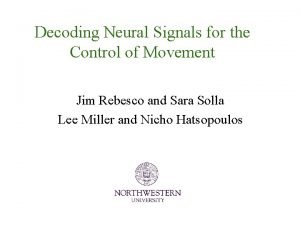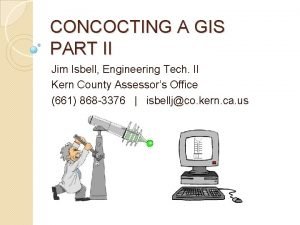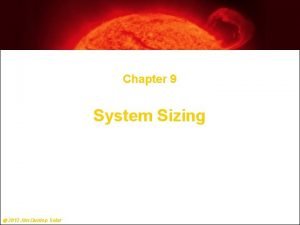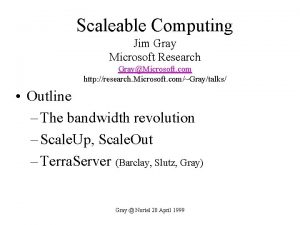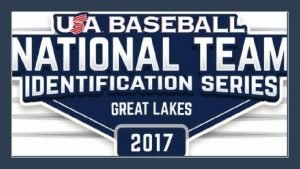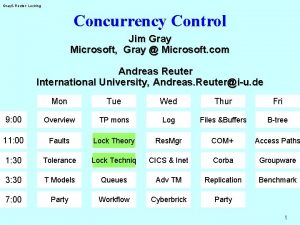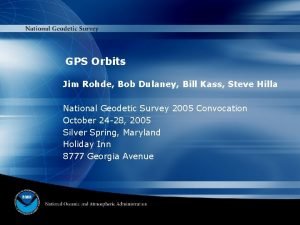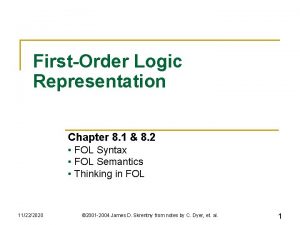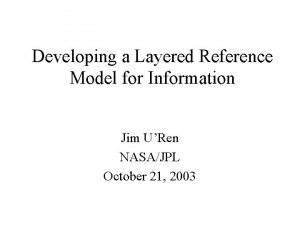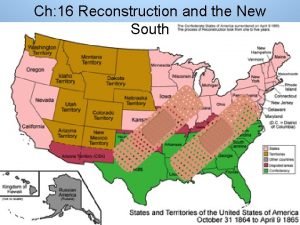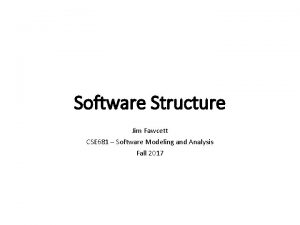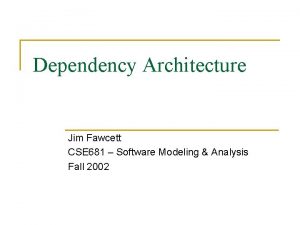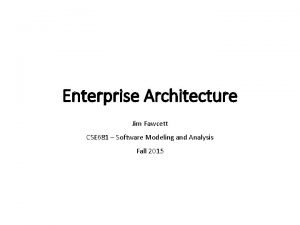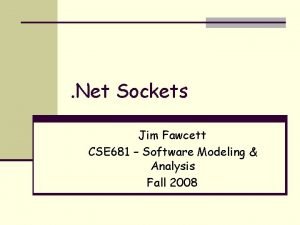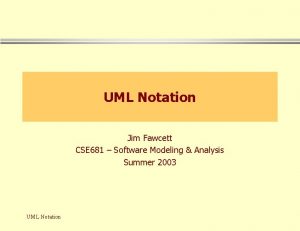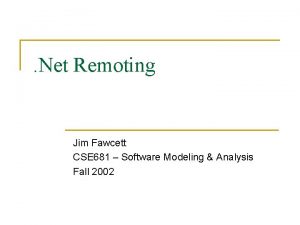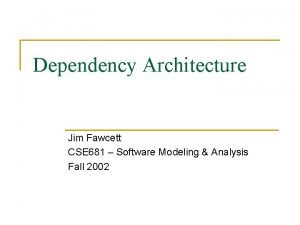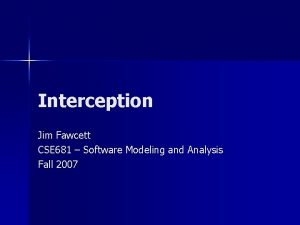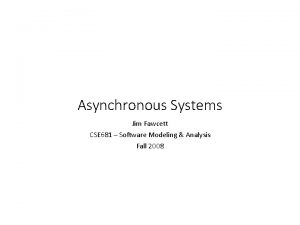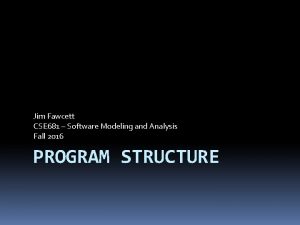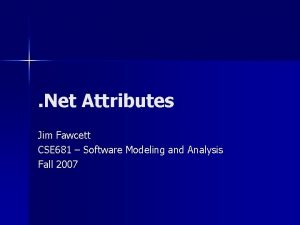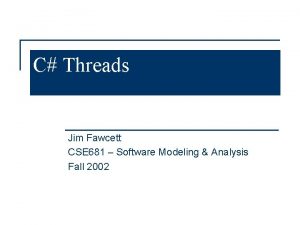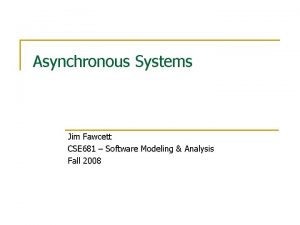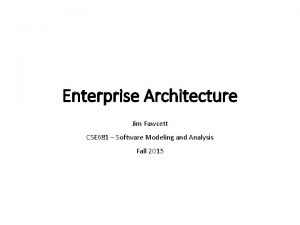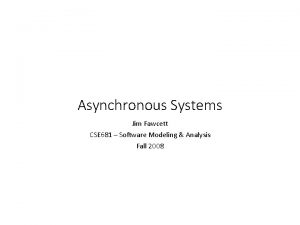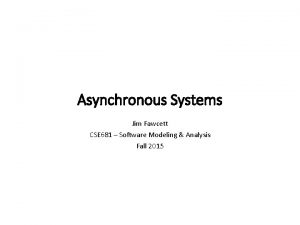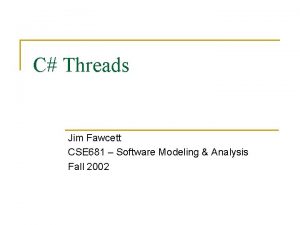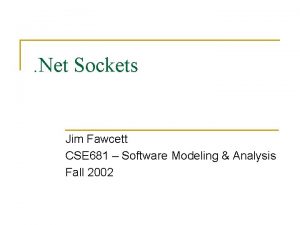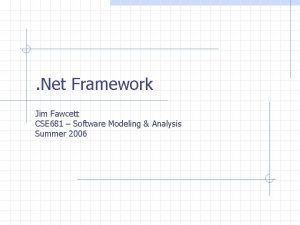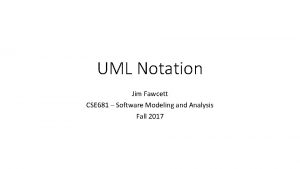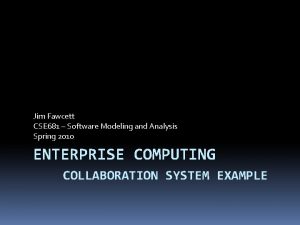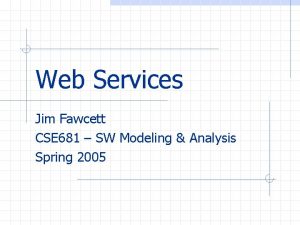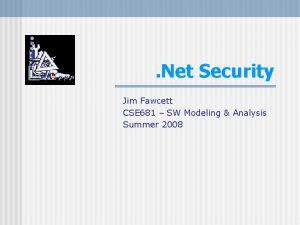Advanced C Jim Fawcett CSE 681 Software Modeling




































































![Attributes Overview [Help. Url(“http: //Some. Url/APIDocs/Some. Class”)] class Some. Class { [Obsolete(“Use Some. New. Attributes Overview [Help. Url(“http: //Some. Url/APIDocs/Some. Class”)] class Some. Class { [Obsolete(“Use Some. New.](https://slidetodoc.com/presentation_image_h2/54e748b7eee0ce0a5bae467a9a74dc3c/image-69.jpg)



![Attributes Querying Attributes [Help. Url("http: //Some. Url/My. Class")] class Class 1 {} [Help. Url("http: Attributes Querying Attributes [Help. Url("http: //Some. Url/My. Class")] class Class 1 {} [Help. Url("http:](https://slidetodoc.com/presentation_image_h2/54e748b7eee0ce0a5bae467a9a74dc3c/image-73.jpg)


![Preprocessor Directives Conditional Compilation #define Debug public class Debug { [Conditional("Debug")] public static void Preprocessor Directives Conditional Compilation #define Debug public class Debug { [Conditional("Debug")] public static void](https://slidetodoc.com/presentation_image_h2/54e748b7eee0ce0a5bae467a9a74dc3c/image-76.jpg)






![Unsafe Code Overview class File. Stream: Stream { int handle; public unsafe int Read(byte[] Unsafe Code Overview class File. Stream: Stream { int handle; public unsafe int Read(byte[]](https://slidetodoc.com/presentation_image_h2/54e748b7eee0ce0a5bae467a9a74dc3c/image-83.jpg)


- Slides: 85

Advanced C # Jim Fawcett CSE 681 – Software Modeling & Analysis Extracted from (with very minor modifications) Mark Sapossnek CS 594 Computer Science Department Metropolitan College Boston University Find the original set on WWW. Got. Dot. Net. com

Learning Objectives w Advanced features of the C# language n n n Creating custom types with interfaces, classes and structs Delegates and events Miscellaneous topics

Agenda w w w w w Review Object-Oriented Concepts Interfaces Classes and Structs Delegates Events Attributes Preprocessor Directives XML Comments Unsafe Code

Review Key Object-Oriented Concepts w Objects, instances and classes w Identity n Every instance has a unique identity, regardless of its data w Encapsulation n Data and function are packaged together Information hiding An object is an abstraction l User should NOT know implementation details

Review Key Object-Oriented Concepts w Interfaces n n A well-defined contract A set of function members w Types n n An object has a type, which specifies its interfaces and their implementations A variable also can have a type w Inheritance n Types are arranged in a hierarchy l n Base/derived, superclass/subclass Interface vs. implementation inheritance

Review Key Object-Oriented Concepts w Polymorphism n n The ability to use an object without knowing its precise type Three main kinds of polymorphism l l l Inheritance Interfaces Late binding w Dependencies n n For reuse and to facilitate development, systems should be loosely coupled Dependencies should be minimized

Interfaces w An interface defines a contract n n n An interface is a type Includes methods, properties, indexers, events Any class or struct implementing an interface must support all parts of the contract w Interfaces provide no implementation n When a class or struct implements an interface it must provide the implementation w Interfaces provide polymorphism n Many classes and structs may implement a particular interface

Interfaces Example public interface IDelete { void Delete(); } public class Text. Box : IDelete { public void Delete() {. . . } } public class Car : IDelete { public void Delete() {. . . } } Text. Box tb = new Text. Box(); IDelete i. Del = tb; i. Delete(); Car c = new Car(); i. Del = c; i. Delete();

Interfaces Multiple Inheritance w Classes and structs can inherit from multiple interfaces w Interfaces can inherit from multiple interfaces interface IControl { void Paint(); } interface IList. Box: IControl { void Set. Items(string[] items); } interface ICombo. Box: IText. Box, IList. Box { }

Interfaces Explicit Interface Members w If two interfaces have the same method name, you can explicitly specify interface + method name to disambiguate their implementations interface IControl { void Delete(); } interface IList. Box: IControl { void Delete(); } interface ICombo. Box: IText. Box, IList. Box { void IControl. Delete(); void IList. Box. Delete(); }

Classes and Structs Similarities w Both are user-defined types w Both can implement multiple interfaces w Both can contain n Data l n Functions l n Fields, constants, events, arrays Methods, properties, indexers, operators, constructors Type definitions l Classes, structs, enums, interfaces, delegates

Classes and Structs Differences Class Struct Reference type Value type Can inherit from any non-sealed reference type No inheritance (inherits only from System. Value. Type) Can have a destructor No destructor Can have user-defined parameterless constructor No user-defined parameterless constructor

Classes and Structs C# Structs vs. C++ Structs w Very different from C++ struct C++ Struct C# Struct Same as C++ class, but all members are public User-defined value type Can be allocated on the heap, on the stack or as a member (can be used as value or reference) Always allocated on the stack or as a member Members are always public Members can be public, internal or private

Classes and Structs Class public class Car : Vehicle { public enum Make { GM, Honda, BMW } Make make; string vid; Point location; Car(Make m, string vid; Point loc) { this. make = m; this. vid = vid; this. location = loc; } Car c = new Car(Car. Make. BMW, “JF 3559 QT 98”, new Point(3, 7)); c. Drive(); public void Drive() { Console. Write. Line(“vroom”); } }

Classes and Structs Struct public struct Point { int x, y; public Point(int x, int y) { this. x = x; this. y = y; } public int X { get { return x; } set { x = value; } } public int Y { get { return y; } set { y = value; } } } Point p = new Point(2, 5); p. X += 100; int px = p. X; // px = 102

Classes and Structs Static vs. Instance Members w By default, members are per instance n n Each instance gets its own fields Methods apply to a specific instance w Static members are per type n n Static methods can’t access instance data No this variable in static methods w Don’t abuse static members n They are essentially object-oriented global data and global functions

Classes and Structs Access Modifiers w Access modifiers specify who can use a type or a member w Access modifiers control encapsulation w Top-level types (those directly in a namespace) can be public or internal w Class members can be public, private, protected, internal, or protected internal w Struct members can be public, private or internal

Classes and Structs Access Modifiers If the access modifier is Then a member defined in type T and assembly A is accessible public to everyone private within T only (the default) protected to T or types derived from T internal to types within A protected internal to T or types derived from T or to types within A

Classes and Structs Abstract Classes w An abstract class is one that cannot be instantiated w Intended to be used as a base class w May contain abstract and non-abstract function members w Similar to an interface w Cannot be sealed

Classes and Structs Sealed Classes w A sealed class is one that cannot be used as a base class w Sealed classes can’t be abstract w All structs are implicitly sealed w Why seal a class? n n To prevent unintended derivation Code optimization l Virtual function calls can be resolved at compile-time

Classes and Structs this w The this keyword is a predefined variable available in non-static function members n Used to access data and function members unambiguously class Person { string name; public Person(string name) { this. name = name; } public void Introduce(Person p) { if (p != this) Console. Write. Line(“Hi, I’m “ + name); } }

Classes and Structs base w The base keyword is used to access class members that are hidden by similarly named members of the current class Shape { int x, y; public override string To. String() { return "x=" + x + ", y=" + y; } } class Circle : Shape { int r; public override string To. String() { return base. To. String() + ", r=" + r; } }

Classes and Structs Constants w A constant is a data member that is evaluated at compile-time and is implicitly static (per type) n e. g. Math. PI public class My. Class { public const string version = “ 1. 0. 0”; public const string s 1 = “abc” + “def”; public const int i 3 = 1 + 2; public const double PI_I 3 = i 3 * Math. PI; public const double s = Math. Sin(Math. PI); . . . } //ERROR

Classes and Structs Fields w A field is a member variable w Holds data for a class or struct w Can hold: n n n a class instance (a reference), a struct instance (actual data), or an array of class or struct instances (an array is actually a reference)

Classes and Structs Readonly Fields w Similar to a const, but is initialized at run-time in its declaration or in a constructor n Once initialized, it cannot be modified w Differs from a constant n Initialized at run-time (vs. compile-time) l n Don’t have to re-compile clients Can be static or per-instance public class My. Class { public static readonly double d 1 = Math. Sin(Math. PI); public readonly string s 1; public My. Class(string s) { s 1 = s; } }

Classes and Structs Properties w A property is a virtual field w Looks like a field, but is implemented with code w Can be public class Button: Control { read-only, private string caption; public string Caption { write-only, get { return caption; } set { caption = value; or read/write Repaint(); } } } Button b = new Button(); b. Caption = "OK"; String s = b. Caption;

Classes and Structs Indexers w An indexer lets an instance behave as a virtual array w Can be overloaded (e. g. index by int and by string) w Can be public class List. Box: Control { private string[] items; read-only, public string this[int index] { get { return items[index]; } write-only, set { items[index] = value; or read/write Repaint(); } } } List. Box list. Box = new List. Box(); list. Box[0] = "hello"; Console. Write. Line(list. Box[0]);

Classes and Structs Methods w All code executes in a method n n Constructors, destructors and operators are special types of methods Properties and indexers are implemented with get/set methods w Methods have argument lists w Methods contain statements w Methods can return a value n Only if return type is not void

Classes and Structs Method Argument Passing w By default, data is passed by value w A copy of the data is created and passed to the method w For value types, variables cannot be modified by a method call w For reference types, the instance can be modified by a method call, but the variable itself cannot be modified by a method call

Classes and Structs Method Argument Passing w The ref modifier causes arguments to be passed by reference w Allows a method call to modify a variable w Have to use ref modifier in method definition and the code that calls it w Variable has to have a value before call void Ref. Function(ref int p) { p++; int x = 10; } Ref. Function(ref x); // x is now 11

Classes and Structs Method Argument Passing w The out modifier causes arguments to be passed out by reference w Allows a method call to initialize a variable w Have to use out modifier in method definition and the code that calls it w Argument has to have a value before returning void Out. Function(out int p) { p = 22; int x; } Out. Function(out x); // x is now 22

Classes and Structs Overloaded Methods w A type may overload methods, i. e. provide multiple methods with the same name w Each must have a unique signature w Signature is based upon arguments only, the return value is ignored void Print(int i); void Print(string s); void Print(char c); void Print(float f); int Print(float f); // Error: duplicate signature

Classes and Structs Parameter Arrays w Methods can have a variable number of arguments, called a parameter array w params keyword declares parameter array w Must be last argument int Sum(params int[] int. Arr) { int sum = 0; foreach (int i in int. Arr) sum += i; return sum; int sum = Sum(13, 87, 34); }

Classes and Structs Virtual Methods w Methods may be virtual or non-virtual (default) w Non-virtual methods are not polymorphic n They cannot be overridden w Non-virtual methods cannot be abstract class Foo { public void Do. Something(int i) {. . . } } Foo f = new Foo(); f. Do. Something();

Classes and Structs Virtual Methods w Defined in a base class w Can be overridden in derived classes n Derived classes provide their own specialized implementation w May contain a default implementation n Use abstract method if no default implementation w A form of polymorphism w Properties, indexers and events can also be virtual

Classes and Structs Virtual Methods class Shape { public virtual void Draw() {. . . } } class Box : Shape { public override void Draw() {. . . } } class Sphere : Shape { public override void Draw() {. . . } } void Handle. Shape(Shape s) { s. Draw(); . . . } Handle. Shape(new Box()); Handle. Shape(new Sphere()); Handle. Shape(new Shape());

Classes and Structs Abstract Methods w An abstract method is virtual and has no implementation w Must belong to an abstract class w Intended to be implemented in a derived class

Classes and Structs Abstract Methods abstract class Shape { public abstract void Draw(); } class Box : Shape { public override void Draw() {. . . } } class Sphere : Shape { public override void Draw() {. . . } } void Handle. Shape(Shape s) { s. Draw(); . . . } Handle. Shape(new Box()); Handle. Shape(new Sphere()); Handle. Shape(new Shape()); // Error!

Classes and Structs Method Versioning w Must explicitly use override or new keywords to specify versioning intent w Avoids accidental overriding w Methods are non-virtual by default w C++ and Java product fragile base classes – cannot specify versioning intent

Classes and Structs Method Versioning class Base { // version 2 1 } public virtual void Foo() { Console. Write. Line("Base. Foo"); } } class Derived: Base { // // version 2 a 1 2 b new public virtual override virtual void Foo() {{ { Console. Write. Line("Derived. Foo"); base. Foo(); } Console. Write. Line("Derived. Foo"); } } }

Classes and Structs Constructors w Instance constructors are special methods that are called when a class or struct is instantiated w Performs custom initialization w Can be overloaded w If a class doesn’t define any constructors, an implicit parameterless constructor is created w Cannot create a parameterless constructor for a struct n All fields initialized to zero/null

Classes and Structs Constructor Initializers w One constructor can call another with a constructor initializer w Can call this(. . . ) or base(. . . ) w Default constructor initializer is base() class B { private int h; public B() { } public B(int h) { this. h = h; } } class D : B { private int i; public D() : this(24) { } public D(int i) { this. i = i; } public D(int h, int i) : base(h) { this. i = i; } }

Classes and Structs Static Constructors w A static constructor lets you create initialization code that is called once for the class w Guaranteed to be executed before the first instance of a class or struct is created and before any static member of the class or struct is accessed w No other guarantees on execution order w Only one static constructor per type w Must be parameterless

Classes and Structs Destructors w A destructor is a method that is called before an instance is garbage collected w Used to clean up any resources held by the instance, do bookkeeping, etc. w Only classes, not structs can have destructors class Foo { ~Foo() { Console. Write. Line(“Destroyed {0}”, this); } }

Classes and Structs Destructors w Unlike C++, C# destructors are non-deterministic w They are not guaranteed to be called at a specific time w They are guaranteed to be called before shutdown w Use the using statement and the IDisposable interface to achieve deterministic finalization

Classes and Structs Operator Overloading w User-defined operators w Must be a static method class Car { string vid; public static bool operator ==(Car x, Car y) { return x. vid == y. vid; } }

Classes and Structs Operator Overloading w Overloadable unary operators + - ! ~ true false ++ -- w Overloadable binary operators + - * / ! ~ % & | ^ == != << >> < > <= >=

Classes and Structs Operator Overloading w No overloading for member access, method invocation, assignment operators, nor these operators: sizeof, new, is, as, typeof, checked, unchecked, &&, ||, and ? : w The && and || operators are automatically evaluated from & and | w Overloading a binary operator (e. g. *) implicitly overloads the corresponding assignment operator (e. g. *=)

Classes and Structs Operator Overloading struct Vector { int x, y; public Vector(x, y) { this. x = x; this. y = y; } public static Vector operator +(Vector a, Vector b) { return Vector(a. x + b. x, a. y + b. y); }. . . }

Classes and Structs Conversion Operators w User-defined explicit and implicit conversions class Note { int value; // Convert to public static return. . . ; } } hertz – no loss of precision implicit operator double(Note x) { nearest note explicit operator Note(double x) { Note n = (Note)442. 578; double d = n;

Classes and Structs Implementing Interfaces w Classes and structs can implement multiple interfaces w A class or struct that inherits from an interface must implement all function members defined in that interface

Classes and Structs Implementing Interfaces public interface IDelete { void Delete(); } public class Text. Box : IDelete { public void Delete() {. . . } } public class Car : IDelete { public void Delete() {. . . } } Text. Box tb = new Text. Box(); IDelete i. Del = tb; i. Delete(); Car c = new Car(); i. Del = c; i. Delete();

Classes and Structs Implementing Interfaces w Explicit interface implementation w Handles name collisions public interface IDelete { void Delete(); } public interface IFoo { void Delete(); } public class Text. Box : IDelete, IFoo { public void IDelete() {. . . } public void IFoo. Delete() {. . . } }

Classes and Structs Nested Types w Declared within the scope of another type w Nesting a type provides three benefits: n n n Nested type can access all the members of its enclosing type, regardless of access modifer Nested type can be hidden from other types Accessing a nested type from outside the enclosing type requires specifying the type name w Nested types can be declared new to hide inherited types w Unlike Java inner classes, nested types imply no relationship between instances

Classes and Structs is Operator w The is operator is used to dynamically test if the run-time type of an object is compatible with a given type static void Do. Something(object o) { if (o is Car) ((Car)o). Drive(); } w Don’t abuse the is operator: it is preferable to design an appropriate type hierarchy with polymorphic methods

Classes and Structs as Operator w The as operator tries to convert a variable to a specified type; if no such conversion is possible the result is null static void Do. Something(object o) { Car c = o as Car; if (c != null) c. Drive(); } w More efficient than using is operator: test and convert in one operation w Same design warning as with the is operator

Classes and Structs typeof Operator w The typeof operator returns the System. Type object for a specified type w Can then use reflection to dynamically obtain information about the type Console. Write. Line(typeof(int). Full. Name); Console. Write. Line(typeof(System. Int). Name); Console. Write. Line(typeof(float). Module); Console. Write. Line(typeof(double). Is. Public); Console. Write. Line(typeof(Car). Member. Type);

Delegates Overview w A delegate is a reference type that defines a method signature w A delegate instance holds one or more methods n n n Essentially an “object-oriented function pointer” Methods can be static or non-static Methods can return a value w Provides polymorphism for individual functions w Foundation for event handling

Delegates Overview delegate double Del(double x); // Declare static void Demo. Delegates() { Del del. Inst = new Del(Math. Sin); double x = del. Inst(1. 0); } // Instantiate // Invoke

Delegates Multicast Delegates w A delegate can hold and invoke multiple methods n Multicast delegates must contain only methods that return void, else there is a run-time exception w Each delegate has an invocation list n Methods are invoked sequentially, in the order added w The += and -= operators are used to add and remove delegates, respectively w += and -= operators are thread-safe

Delegates Multicast Delegates delegate void Some. Event(int x, int y); static void Foo 1(int x, int y) { Console. Write. Line("Foo 1"); } static void Foo 2(int x, int y) { Console. Write. Line("Foo 2"); } public static void Main() { Some. Event func = new Some. Event(Foo 1); func += new Some. Event(Foo 2); func(1, 2); // Foo 1 and Foo 2 are called func -= new Some. Event(Foo 1); func(2, 3); // Only Foo 2 is called }

Delegates and Interfaces w Could always use interfaces instead of delegates w Interfaces are more powerful n n Multiple methods Inheritance w Delegates are more elegant for event handlers n n Less code Can easily implement multiple event handlers on one class/struct

Events Overview w Event handling is a style of programming where one object notifies another that something of interest has occurred n A publish-subscribe programming model w Events allow you to tie your own code into the functioning of an independently created component w Events are a type of “callback” mechanism

Events Overview w Events are well suited for user-interfaces n The user does something (clicks a button, moves a mouse, changes a value, etc. ) and the program reacts in response w Many other uses, e. g. n n Time-based events Asynchronous operation completed Email message has arrived A web session has begun

Events Overview w w C# has native support for events Based upon delegates An event is essentially a field holding a delegate However, public users of the class can only register delegates n n They can only call += and -= They can’t invoke the event’s delegate w Multicast delegates allow multiple objects to register with the same event

Events Example: Component-Side w Define the event signature as a delegate public delegate void Event. Handler(object sender, Event. Args e); w Define the event and firing logic public class Button { public event Event. Handler Click; protected void On. Click(Event. Args e) { // This is called when button is clicked if (Click != null) Click(this, e); } }

Events Example: User-Side w Define and register an event handler public class My. Form: Form { Button ok. Button; static void Ok. Clicked(object sender, Event. Args e) { Show. Message("You pressed the OK button"); } public My. Form() { ok. Button = new Button(. . . ); ok. Button. Caption = "OK"; ok. Button. Click += new Event. Handler(Ok. Clicked); } }

Attributes Overview w It’s often necessary to associate information (metadata) with types and members, e. g. n n Documentation URL for a class Transaction context for a method XML persistence mapping COM Prog. ID for a class w Attributes allow you to decorate a code element (assembly, module, type, member, return value and parameter) with additional information
![Attributes Overview Help Urlhttp Some UrlAPIDocsSome Class class Some Class ObsoleteUse Some New Attributes Overview [Help. Url(“http: //Some. Url/APIDocs/Some. Class”)] class Some. Class { [Obsolete(“Use Some. New.](https://slidetodoc.com/presentation_image_h2/54e748b7eee0ce0a5bae467a9a74dc3c/image-69.jpg)
Attributes Overview [Help. Url(“http: //Some. Url/APIDocs/Some. Class”)] class Some. Class { [Obsolete(“Use Some. New. Method instead”)] public void Some. Old. Method() {. . . } public string Test([Some. Attr()] string param 1) {. . . } }

Attributes Overview w Attributes are superior to the alternatives n n Modifying the source language Using external files, e. g. , . IDL, . DEF w Attributes are extensible n n Attributes allow to you add information not supported by C# itself Not limited to predefined information w Built into the. NET Framework, so they work across all. NET languages n Stored in assembly metadata

Attributes Overview w Some predefined. NET Framework attributes Attribute Name Description Browsable Should a property or event be displayed in the property window Serializable Allows a class or struct to be serialized Obsolete Compiler will complain if target is used Prog. Id COM Prog ID Transactional characteristics of a class

Attributes Overview w Attributes can be n n Attached to types and members Examined at run-time using reflection w Completely extensible n Simply a class that inherits from System. Attribute w Type-safe n Arguments checked at compile-time w Extensive use in. NET Framework n XML, Web Services, security, serialization, component model, COM and P/Invoke interop, code configuration…
![Attributes Querying Attributes Help Urlhttp Some UrlMy Class class Class 1 Help Urlhttp Attributes Querying Attributes [Help. Url("http: //Some. Url/My. Class")] class Class 1 {} [Help. Url("http:](https://slidetodoc.com/presentation_image_h2/54e748b7eee0ce0a5bae467a9a74dc3c/image-73.jpg)
Attributes Querying Attributes [Help. Url("http: //Some. Url/My. Class")] class Class 1 {} [Help. Url("http: //Some. Url/My. Class"), Help. Url("http: //Some. Url/My. Class”, Tag=“ctor”)] class Class 2 {} Type type = typeof(My. Class); foreach (object attr in type. Get. Custom. Attributes() ) { if ( attr is Help. Url. Attribute ) { Help. Url. Attribute ha = (Help. Url. Attribute) attr; my. Browser. Navigate( ha. Url ); } }

Preprocessor Directives Overview w C# provides preprocessor directives that serve a number of functions w Unlike C++, there is not a separate preprocessor n The “preprocessor” name is preserved only for consistency with C++ w C++ preprocessor features removed include: n n #include: Not really needed with one-stop programming; removal results in faster compilation Macro version of #define: removed for clarity

Preprocessor Directives Overview Directive #define, #undef Description Define and undefine conditional symbols #if, #else, #endif Conditionally skip sections of code #error, #warning Issue errors and warnings #region, #end Delimit outline regions #line Specify line number
![Preprocessor Directives Conditional Compilation define Debug public class Debug ConditionalDebug public static void Preprocessor Directives Conditional Compilation #define Debug public class Debug { [Conditional("Debug")] public static void](https://slidetodoc.com/presentation_image_h2/54e748b7eee0ce0a5bae467a9a74dc3c/image-76.jpg)
Preprocessor Directives Conditional Compilation #define Debug public class Debug { [Conditional("Debug")] public static void Assert(bool cond, String s) { if (!cond) { throw new Assertion. Exception(s); } } void Do. Something() {. . . // If Debug is not defined, the next line is // not even called Assert((x == y), “X should equal Y”); . . . } }

Preprocessor Directives Assertions w By the way, assertions are an incredible way to improve the quality of your code w An assertion is essentially a unit test built right into your code w You should have assertions to test preconditions, postconditions and invariants w Assertions are only enabled in debug builds w Your code is QA’d every time it runs w Must read: “Writing Solid Code”, by Steve Maguire, Microsoft Press, ISBN 1 -55615 -551 -4

XML Comments Overview w Programmers don’t like to document code, so we need a way to make it easy for them to produce quality, up-to-date documentation w C# lets you embed XML comments that document types, members, parameters, etc. n Denoted with triple slash: /// w XML document is generated when code is compiled with /doc argument w Comes with predefined XML schema, but you can add your own tags too n Some are verified, e. g. parameters, exceptions, types

XML Comments Overview XML Tag Description <summary>, <remarks> Type or member <param> Method parameter <returns> Method return value <exception> Exceptions thrown from method <example>, <code> Sample code <see>, <seealso> Cross references <value> Property <paramref> Use of a parameter <list>, <item>, . . . Formatting hints <permission> Permission requirements

XML Comments Overview class Xml. Element { /// <summary> /// Returns the attribute with the given name and /// namespace</summary> /// <param name="name"> /// The name of the attribute</param> /// <param name="ns"> /// The namespace of the attribute, or null if /// the attribute has no namespace</param> /// <return> /// The attribute value, or null if the attribute /// does not exist</return> /// <seealso cref="Get. Attr(string)"/> /// public string Get. Attr(string name, string ns) {. . . } }

Unsafe Code Overview w Developers sometime need total control n n Performance extremes Dealing with existing binary structures Existing code Advanced COM support, DLL import w C# allows you to mark code as unsafe, allowing n n Pointer types, pointer arithmetic ->, * operators Unsafe casts No garbage collection

Unsafe Code Overview w Lets you embed native C/C++ code w Basically “inline C” w Must ensure the GC doesn’t move your data n n Use fixed statement to pin data Use stackalloc operator so memory is allocated on stack, and need not be pinned unsafe void Foo() { char* buf = stackalloc char[256]; for (char* p = buf; p < buf + 256; p++) *p = 0; . . . }
![Unsafe Code Overview class File Stream Stream int handle public unsafe int Readbyte Unsafe Code Overview class File. Stream: Stream { int handle; public unsafe int Read(byte[]](https://slidetodoc.com/presentation_image_h2/54e748b7eee0ce0a5bae467a9a74dc3c/image-83.jpg)
Unsafe Code Overview class File. Stream: Stream { int handle; public unsafe int Read(byte[] buffer, int index, int count) { int n = 0; fixed (byte* p = buffer) { Read. File(handle, p + index, count, &n, null); } return n; } [dllimport("kernel 32", Set. Last. Error=true)] static extern unsafe bool Read. File(int h. File, void* lp. Buffer, int n. Bytes. To. Read, int* n. Bytes. Read, Overlapped* lp. Overlapped); }

Unsafe Code C# and Pointers w Power comes at a price! n n Unsafe means unverifiable code Stricter security requirements l l Before the code can run Downloading code

More Resources w w w http: //msdn. microsoft. com http: //windows. oreilly. com/news/hejlsberg_0800. html http: //www. csharphelp. com/ http: //www. csharp-station. com/ http: //www. csharpindex. com/ http: //msdn. microsoft. com/msdnmag/issues/0900/csharp/cs harp. asp w http: //www. hitmill. com/programming/dot. NET/csharp. html w http: //www. c-sharpcorner. com/ w http: //msdn. microsoft. com/library/default. asp? URL=/libr ary/dotnet/csspec/vclrfcsharpspec_Start. htm
 Iron abbey gastropub
Iron abbey gastropub 681 complex inc
681 complex inc Cs 681
Cs 681 Round 246 to the nearest hundred
Round 246 to the nearest hundred Cse 598 advanced software analysis and design
Cse 598 advanced software analysis and design Helen c. erickson nursing theory
Helen c. erickson nursing theory Relational modeling vs dimensional modeling
Relational modeling vs dimensional modeling Margerie bonner
Margerie bonner Example of coercion
Example of coercion Brian fawcett
Brian fawcett Hamilton was born where
Hamilton was born where Philippa fawcett
Philippa fawcett Barry fawcett
Barry fawcett Dennis fawcett
Dennis fawcett Dr richard fawcett
Dr richard fawcett Graham fawcett
Graham fawcett Fawcett definition
Fawcett definition Barry fawcett
Barry fawcett Jonathan ruby
Jonathan ruby Nested state diagram
Nested state diagram Advanced part modeling
Advanced part modeling Btm 382
Btm 382 Advanced process modelling
Advanced process modelling Plasma simulation software
Plasma simulation software Context models in software engineering
Context models in software engineering Rf propagation modeling software
Rf propagation modeling software Antenna modeling software free
Antenna modeling software free What is system modeling in software engineering
What is system modeling in software engineering Scenario based modeling in software engineering
Scenario based modeling in software engineering What is class based modeling in software engineering
What is class based modeling in software engineering Class based modeling in software engineering
Class based modeling in software engineering Scenario-based modeling in software engineering
Scenario-based modeling in software engineering Traffic modeling software
Traffic modeling software Antenna modeling software
Antenna modeling software Eznec tutorial
Eznec tutorial Advanced topics in software engineering
Advanced topics in software engineering Advanced software development
Advanced software development Advanced macro facility are
Advanced macro facility are Advanced software testing concepts
Advanced software testing concepts Primerica rvp salary
Primerica rvp salary Jim kenney harvard pilgrim
Jim kenney harvard pilgrim Jim gray database
Jim gray database The new jim crow chapter 1
The new jim crow chapter 1 The new jim crow chapter 2
The new jim crow chapter 2 Computer age
Computer age Dr jim young
Dr jim young Jim brau
Jim brau Messin with sasquatch
Messin with sasquatch Hp buys compaq
Hp buys compaq Jim shifflett
Jim shifflett Jim crow character
Jim crow character Hunterdon county democrat
Hunterdon county democrat Susquehanna valley sports
Susquehanna valley sports Who is jim boykin
Who is jim boykin Computer networks kurose
Computer networks kurose Butch killian into the wild
Butch killian into the wild Ihealthevents.com
Ihealthevents.com Flywheel vs doom loop
Flywheel vs doom loop Jim rebesco
Jim rebesco Kern county assessor gis
Kern county assessor gis What type of character is della in the gift of the magi
What type of character is della in the gift of the magi Jim dunlop solar
Jim dunlop solar Jim getzinger
Jim getzinger Jim theofelis
Jim theofelis Jim keller discovery
Jim keller discovery Jim morrison crystal ship
Jim morrison crystal ship Gift of the magi resolution
Gift of the magi resolution Jim gray microsoft
Jim gray microsoft Rti writing interventions
Rti writing interventions Jim crow acrostic poem
Jim crow acrostic poem Dr. jim wright
Dr. jim wright Jim plourde
Jim plourde Slick jim won the lottery
Slick jim won the lottery Jim breslo
Jim breslo Jim clawson
Jim clawson Fur trapping apothecary
Fur trapping apothecary Jim schurr softball
Jim schurr softball Microsoft flow concurrency control
Microsoft flow concurrency control Richard dulaney
Richard dulaney Jim skrentny
Jim skrentny Jim wei
Jim wei Imperative sentence in direct and indirect speech
Imperative sentence in direct and indirect speech Rennasa
Rennasa Walker tariff apush definition
Walker tariff apush definition Apartheid vs jim crow venn diagram
Apartheid vs jim crow venn diagram Jim gordon cape wind
Jim gordon cape wind




